



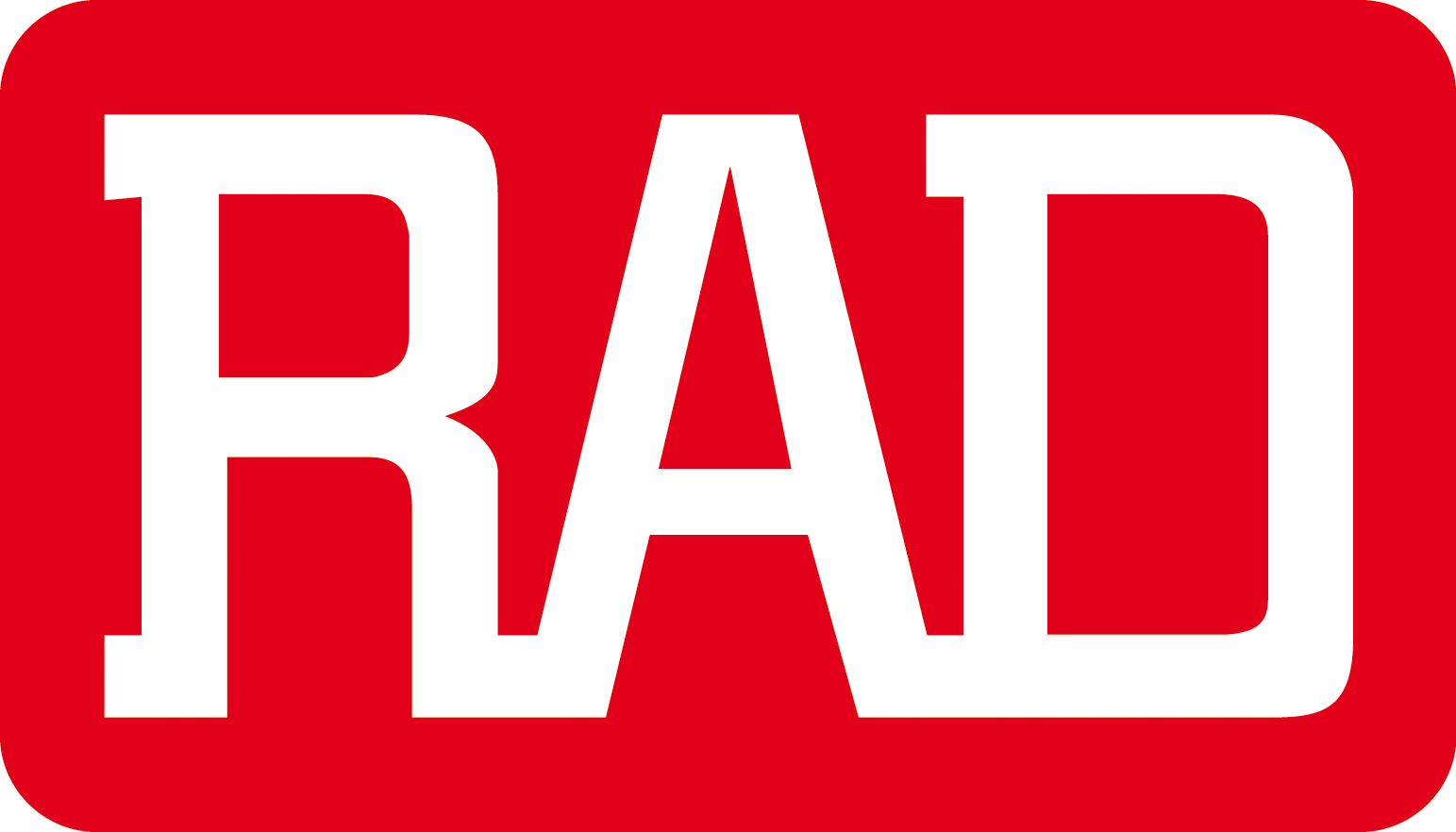
DXC-100 from RAD Data Communications
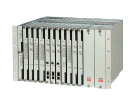
The DXC-100 is a modular, 6U high device and is the latest addition to the DXC family of multiservice access nodes. Each chassis
supports up to 80 n x 56/64 kbps, 88 E1/T1, eleven E3/T3, or four STM-1/OC-3 links. Up to
eight DXC-100 chassis can be stacked to support
up to 640 n x 56/64 kbps, 688 E1/T1, 80 E3/T3 or 8 STM-1/OC-3 lines, for a powerful, central site solution. The scalable
DXC-100 platform
enables carriers to deploy a system with low entry cost to meet their current requirements, and add additional chassis and modules
as their customer base grows.
DXC-100 satisfies the access needs of wireless and wireline operators in a wide range of broadband and narrowband applications for
carriers, cellular operators, ISPs, utility companies and enterprises.
DXC-100 Applications include:
- E1/T1 conversion between two ports of the same module
- High speed access to a carrier’s digital backbone
- E3/T3/STM-1/OC-3 conversion
- Grooming fractional trunks into full trunks
- Maximizing data traffic payload over E1, T1, E3, T3, STM-1 or OC-3 trunks
- Grooming monitoring signals for QoS or advanced services.
- DXC-100 optimizes the network by consolidating E1and T1 functionality in a single, cost-effective, managed device. Operating as a digital cross-connect, the DXC-100 provides 3/1/0 non-blocking switching that is comparable to larger, more costly systems.
- DXC-100 can also aggregate Ethernet traffic (for example, ISP or corporate traffic) from several remote sites via different trunks into
one stream by using the channelized router module.
Basic DXC-100 units:
The basic DXC-100 chassis is 10.5” (6U) high, and NEBS Level 3 certified. The chassis includes eleven I/O slots for the plug-in interface module sets. Each module set consists of a front main module and a rear interface module. The power supply and system
manager modules are not provided with the chassis and must be ordered separately. Optional redundancy for the system manager and power supply modules is available.
The chassis can be mounted in a 19” wide rack. Optional 23” flush and 23” center mount brackets are also available.
Up to 8 DXC-100 units can be stacked in a star topology. Nest 1 is a master unit, while nests 2 to 8 are slave units. The master unit
has a different main system manager module (DXNM) and an additional expansion module (DXCC). The slave units have the same
main system manager module (DSMC.2), and an additional stack controller module (DXLC).
When expanding a standalone unit into a stack, all its modules are utilized, and none of the resources is wasted.
DXC-100 SYSTEM MANAGER MODULES
A standalone DXC-100 requires one or two DSMC.2 half-height main modules and one DSMC.2 full-height interface module. Nest 1 in a DXC-100 stack requires one or two (recommended) half-height DXNM main modules with one full height DSMC.2 interface module and one or two (recommended) full-height DXCC main and interface modules. Nests 2 to 8 require one or two DSMC.2 half-height
main modules and one or two (recommended) full-height DXLC main modules. The DSMC.2 interface module is optional and intended
for use only when the DXC-100PSX is used. For each of the DXLC modules, a D8E1T1 interface module can be installed at the rear of
the chassis, to provide additional 8 E1/T1 ports each.
DSMC.2 Main Module
A standalone unit, as well as nests 2 to 8 of stacked units, use the half-height DMSC.2 system management main module, placed in
a specially designed slot. Two such slots are available for optional system redundancy. The DSMC.2 module can generate a Stratum
3 clock source.
DSMC.2 Interface Module
A single full-height interface module supports up to two DSMC.2 or DXNM main modules and is rear-mounted into a dedicated slot.
The interface module contains management 10/100BaseT Ethernet and supervision terminal ports, phone line (connected to internal
modem) and critical/major/minor alarm dry contacts.
DXNM Main Module
Nest 1 of the stacked units uses the half height DXMN system management main module instead of the DSMC.2 module. The DXMN
module is placed in a specially designed slot. Two such slots are available for optional system redundancy. The DXNM module
provides a Stratum 3 or external clock to all units. The interface module for Nest 1 is the same as for a standalone unit
(DSMC.2).
DXCC and DXLC Main and Interface Modules
The Matrix expansion modules are the DXCC module for Nest 1 and the DXLC for Nests 2 to 8. The DXCC and DXLC modules are
connected via an external cable. The DXCC creates a transparent switch fabric for a non-blocking 3/1/0 cross-connect between any
ports of the stacked units.
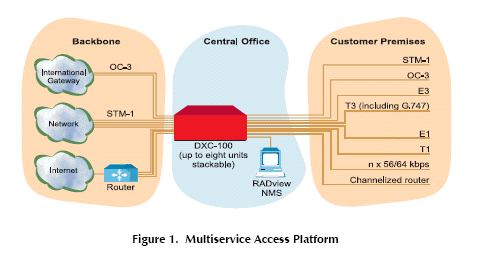
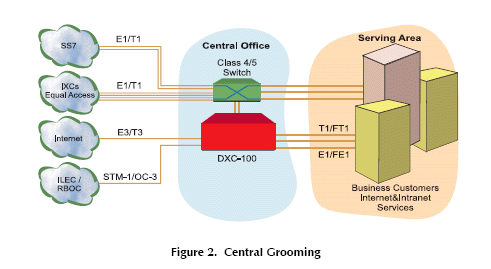
DXC-100 REDUNDANCY (OPTIONAL)
DXC-100PSX is an optional protection switch redundancy unit.
It is an adjunct system to the DXC-100 that provides automatic protection services for E1/T1 and/or DE3/DT3 services on a user
selectable N:1 manner. It occupies only 3U of vertical space directly above the DXC-100 chassis and features fail-safe switch and fan
operation.
DXC-100PSX supports up to 10:1 protection ratio for the D8E1T1 module, up to 6:1 and additional up to 3:1 ratio for DE3 or DT3
modules in a single 11-slot unit. Only one DXC-100PSX can be used with each DXC-100 unit.
The system manager module, DXC-100PSX-NC is connected to the DXC-100 unit by a special cable. The system manager module
(one per unit) and the -48 VDC power supply modules (one or two per unit) must be ordered separately.
I/O MODULES
A DXC-100 standalone unit accommodates up to eleven module sets consisting of a front main module and a rear interface module.
Eight DXC-100 units in a stack accommodate up to 86 module sets.
DSTM-1, the single-port STM-1 module, provides SDH Path Terminating Equipment (PTE) functionality for the DXC-100. The DSTM-1
Module can transmit and terminate any timeslot from up to 84 T1 or 63 E1 channels per STM-1 facility. Mixed (E1 and T1) traffic
applications are also supported. When utilized with a companion STM-1 module set in an adjacent slot, 1:1 redundancy is provided.
DOC-3, the single-port OC-3 module, provides SONET PTE functionality for the DXC-100. The DOC-3 Module can transmit and
terminate any timeslot from up to 84 T1 links per OC-3 facility. When utilized with a companion OC-3 module set in an adjacent
slot, 1:1 redundancy is provided. DT3, the single-port T3 interface module, multiplexes any timeslotfrom up to 28 T1 links or 21 E1 links into a single T3 stream with
either C-bit parity or M13 framing. Mixed (E1 and T1) traffic applications are also supported, as per ITU G.747. The module has an
integral BERT and supports loopback diagnostics. Up to 6:1 hardware redundancy is available via the DXC-100PSX unit.
DE3, the single-port E3 interface module, allows the DXC-100 to transmit and terminate an E3 link. Additionally, it multiplexes and
demultiplexes any timeslot from up to 16 E1 links. The module has an integral BERT and supports loopback diagnostics. Up to 6:1
hardware redundancy is available via the DXC-100PSX unit. D8E1T1, the 8-port E1/T1 module, supports up to eight E1 or T1 links, in any combination, with D4, ESF or G.70x framing and AMI,
B8ZS or HDB3 line coding. The module has an integral BERT and supports
loopback diagnostics. Up to 10:1 hardware redundancy is available via the DXC-100PSX unit.
D8HS, the eight-port n x 56/64 kbps data module, provides eight high speed synchronous data channels. The electrical interface for
each port can be configured independently for RS-530, RS-530A, RS-449/422, RS-232, V.35 or X.21 interfaces at the system console.
DROUTER, the 32-channel (2 Mbps) channelized router hub module, allows the DXC-100 to perform the functions of a channelized,
multiprotocol router. The module can be used for inband management of remote units. It supports up to 32 individual channels (1to 32
timeslots) for IP/IPX routing including multiple protocols and additional features such as NAT. An integral SNMP agent is provided.
The rear interface card supports 8-port 10/100Base-T LAN hub functionality and detects status of up to three external contact
closures.
DXC-100 MANAGEMENT
DXC-100 can be managed via the
following options:
- ASCII terminal
- Telnet
- RADview-PC™ SNMP central network management system.
Local and remote configuration and diagnostics reduces operating expenses, eliminates costly technician visits and maximizes
network performance and uptime.
Inband management, an important advantage of the DXC family that enables management of other RAD remote products, is supported
via the DROUTER module.
DXC-100 utilizes an embedded SNMP agent that provides basic system resource monitoring, event notification, diagnostics,
performance monitoring and provisioning. Per the appropriate RFC standards, SNMP uses the UDP protocol to send and receive data and can also be set up so that only selcted devices are authorized to view or change information. The set of read/write parameters
allows for basic slot configuration, circuit/connection set-up for all 5 cross-connection maps, system clock and source assignment as
well as D8E1T1, DE3, DT3 and D8HS data application module provisioning. A set of read-only parameters allows for monitoring system status and alarms, as well as performing limited diagnostics.
All DXC-100 and DXC-100PSX management functions are performed on the DSMC.2 system manager module for the standalone unit
or the DXNM master system manager module for the stack. In either case, the same rear DSMC.2 interface module is used. Its physical management ports include the following:
- Supervision terminal: VT-100 compliant serial data interface for local access
- Dial-in modem: integral auto-answer modem for remote dial-up access
- 10/100BaseT Ethernet: IP-based LAN connection supporting local or remote multiple Telnet sessions or EMS access via SNMP.
In addition, the DSMC.2 rear interface module contains dry contacts for sending alarms.
DXC-100 DIAGNOSTICS
All the modules posses a comprehensive suite of integral diagnostic tools that can becontrolled from any of the management interfaces. These diagnostics conform to the appropriate international standards for testing such applications. Each I/O module supports a number of embedded loopbacks (local or remote) and bit error rate (BER) diagnostics. BER testing on the D8HS module is performed at n x 56/64kbps rate, whereas on all the other modules it is performed at a framed or unframed aggregate level.
DXC-100 TIMING
DXC-100 can use Network Synchronized Timing or Internal Timing. Network Synchronized Timing includes line timing that is provided via the channel cards, or external timing provided by standalone reference timing equipment (such as a Building Integrated Timing Source [BITS]). The Internal Timing source is a Stratum 3 clock, which can be used as a reference to generate the system clocking signals. DXC-100 allows the selection of up to three reference clock sources. In the event that a reference clock fails and DXC-100 is configured in auto mode, it will automatically select an alternate input based on the source clock configuration settings.
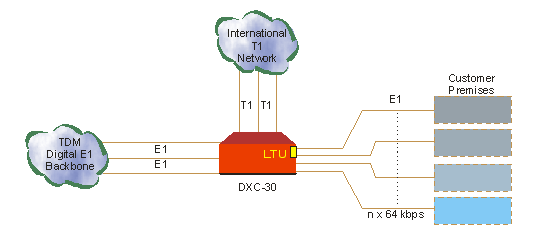
DXC-100 data sheet (pdf)
Octal T1 or E1 DXC-100 module data
sheet (pdf)
T3 DXC-100 module data sheet (pdf)